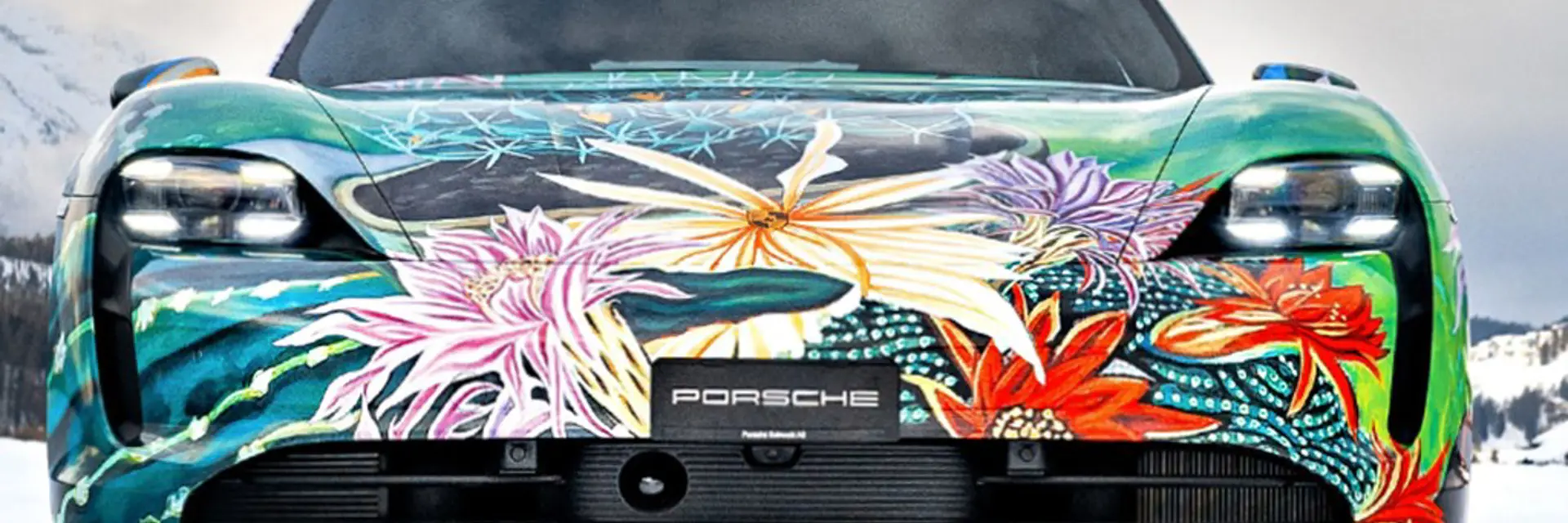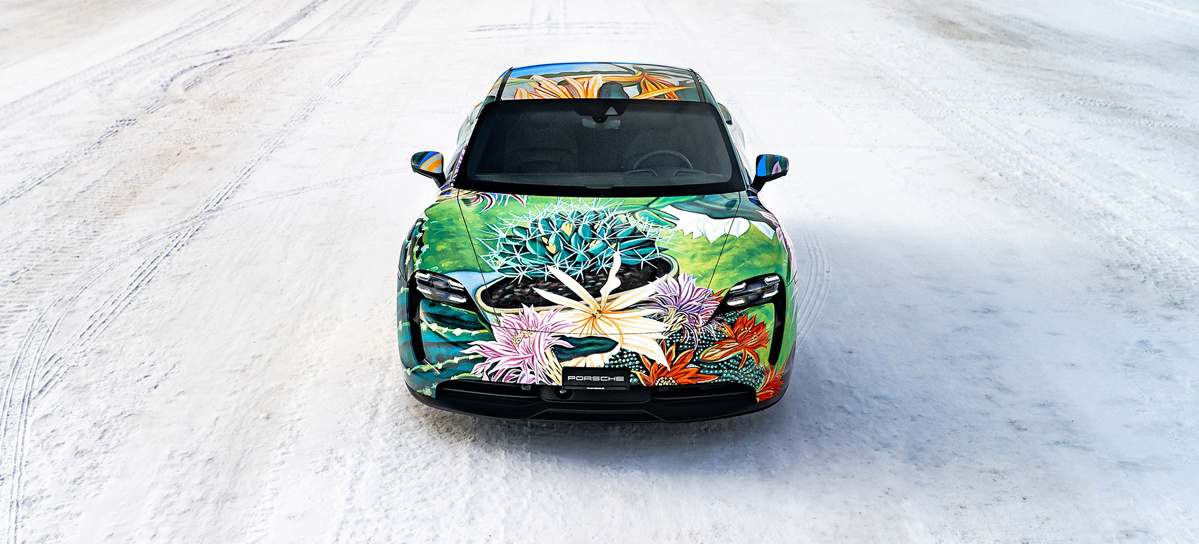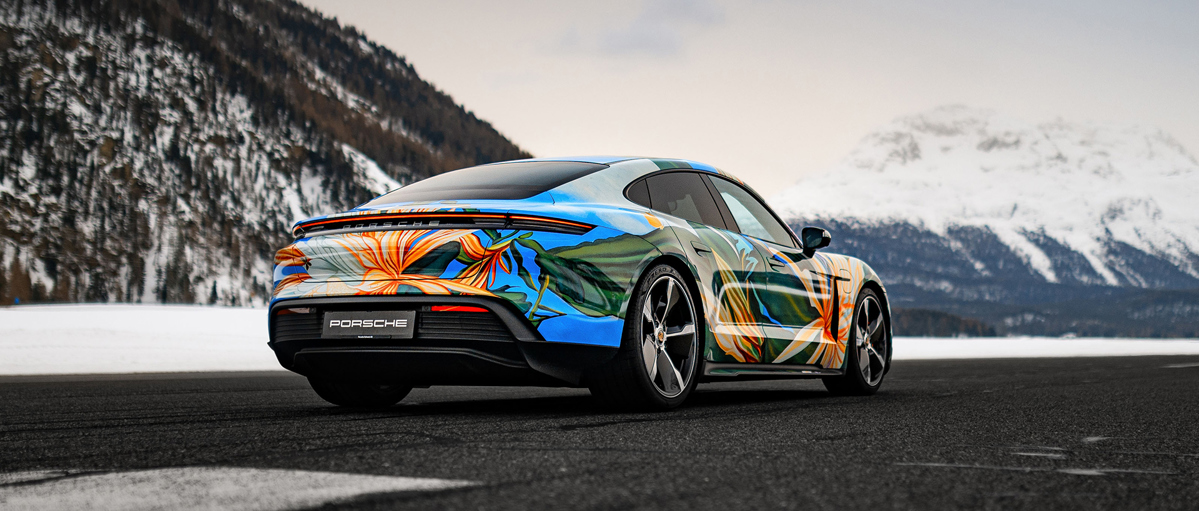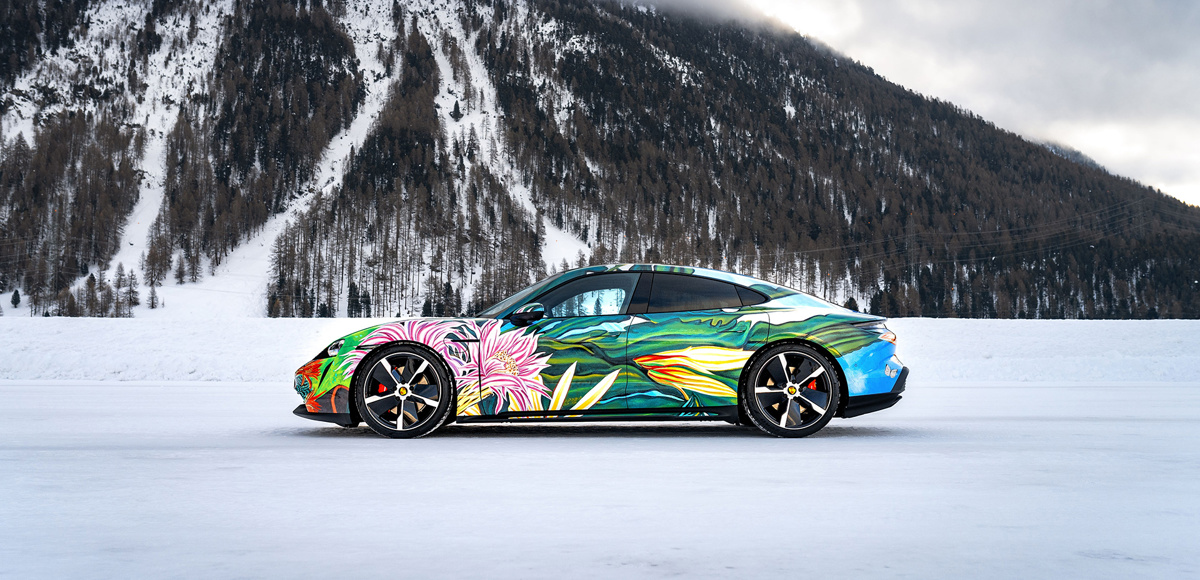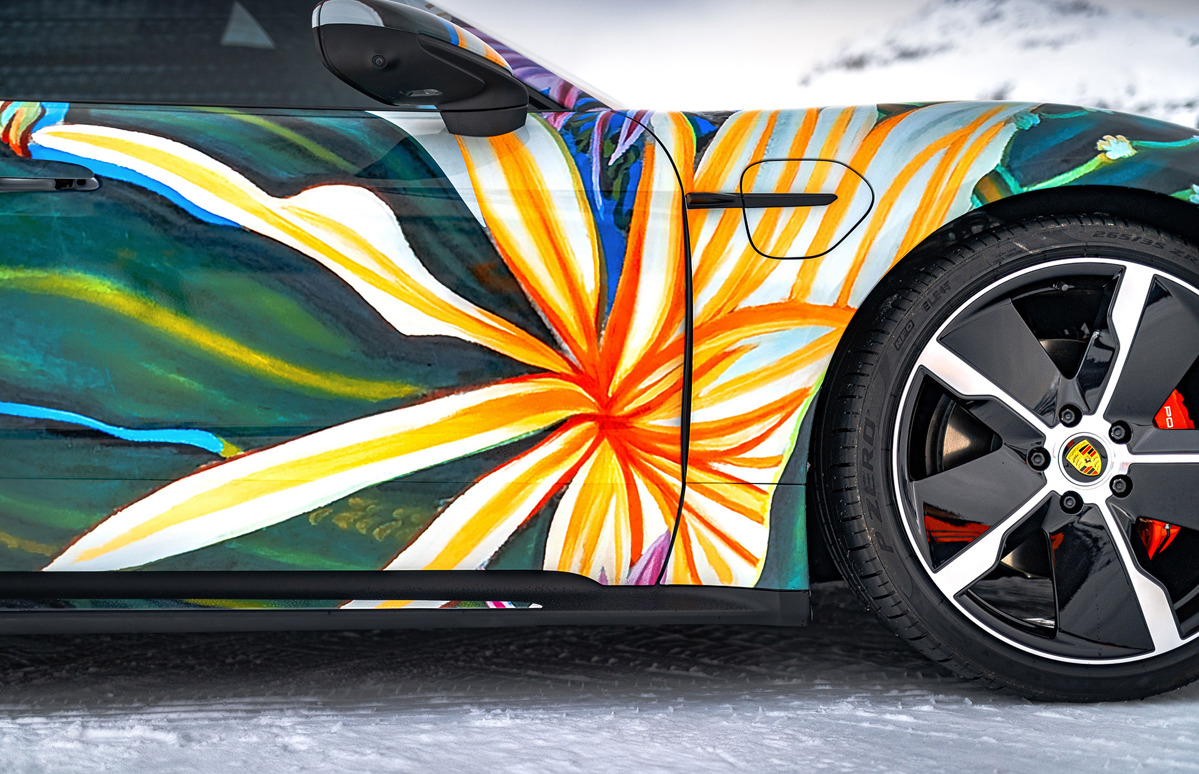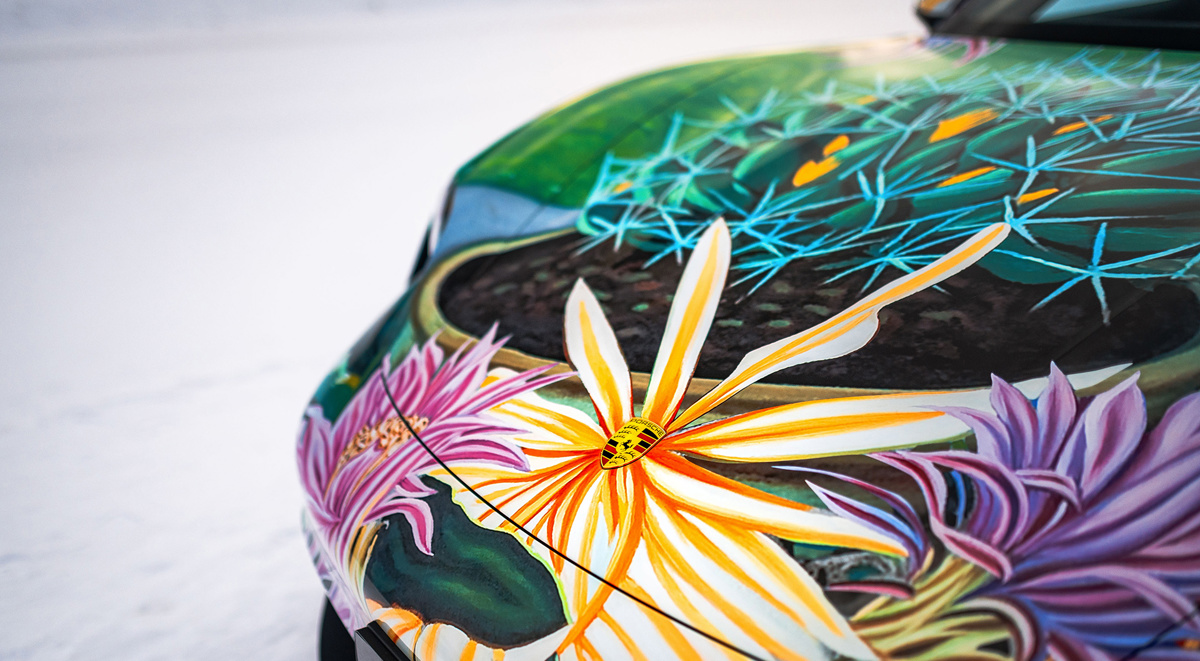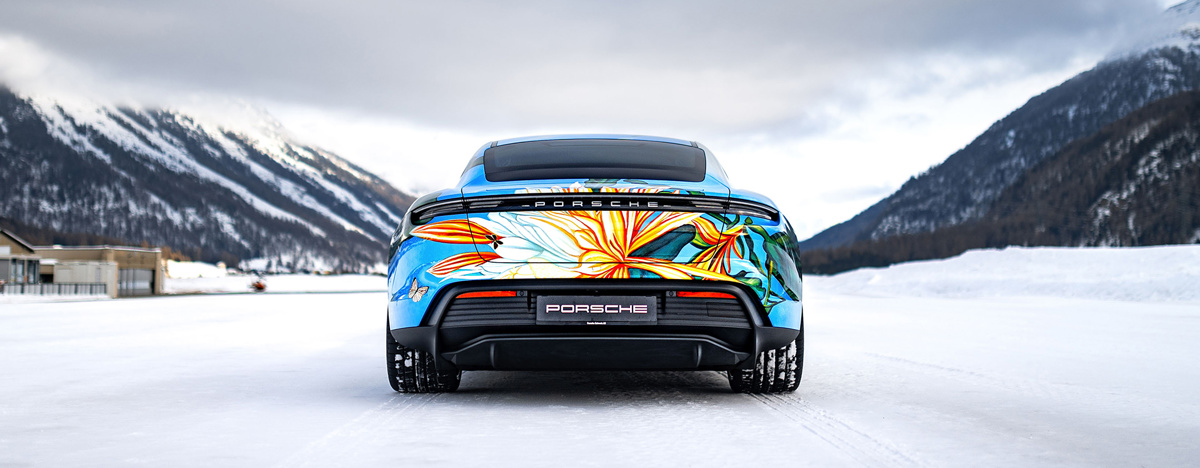Blooming like Edelweiss in deepest winter, the newest Porsche Taycan 4S Artcar by Richard Phillips is a groundbreaking piece in the grand tradition of American artists transforming Stuttgart’s sports cars into extraordinary canvases. Though the seeds of the collaboration between Porsche and New York-based painter Richard Phillips matured over a scant six months, its original source material dates back over a decade, to Phillips’s Queen of the Night from 2010, who has previously used the Swiss landscape as a backdrop for his striking figurative work, including his standout piece from 2008, Der Bodensee.
The accelerated pace with which a worldwide team created this unique Taycan 4S Artcar by Richard Phillips was necessitated in part due to the purpose of this Porsche: Driving awareness of a charity auction to benefit the Suisseculture Sociale, benefitting the full-time creatives that make Swiss culture unique in the world, amid the backdrop of an extraordinary year, when freelancers, galleries, and even well-established institutions all faced the real possibility of closing for business forever.
Developed in the spirit of charity, Porsche and RM Sotheby’s have announced a global, online auction for this one-of-a-kind Artcar, set for the week of 6-13 April 2021. More than a mere livery, the numerous custom features on this one-off example set it apart, down to the doorsills, which are inscribed with “Queen of the Night,” and Phillips’s signature, which is cast in light on the underfloor by miniature projectors—a final flourish worthy of any true artwork.
When asked to distill his latest work down to one word, Phillips emphasized “performance,” which describes both the incredible acceleration of the all-electric Porsche and the performative nature of physically applying one of his flat paintings onto a three-dimensional surface—a feat made even more impressive by the fact that it was directed across an ocean during a worldwide pandemic, with German-based SIGNaL Design hand-shaping Phillips’s vinyl-printed painting on-site at Restaurant Leuehof on Zürich’s Bahnhofstrasse while in constant communication with the artist at his home studio in New York City.
Equally evocative in motion as well as sitting still, that the organic shapes of Queen of the Night flow so perfectly on the finished Artcar should be no surprise, as Phillips’s striking style adapts equally well to album covers, custom-made motorsports helmets, and 24 Hours of Le Mans-winning racecars. In a lively, wide-ranging discussion that touched on the unifying passion of motorsport and the classic Swiss inspiration behind his vibrant still life painting, we caught up with Phillips in his New York studio in advance of the auction:
RM Sotheby’s: Your connection with Porsche predates this Artcar collaboration, could you talk a bit about your background with the brand—I read you had a 1992 911 Turbo at one point, I don’t know if you still have it?
Richard Phillips: No, I sold that car… [laughs] I learned a lot from it, though, and it was the right decision. I got the car back in 2010 after a friend of mine offered a drive in his. He had a black Porsche 911 Turbo, and we went out on the highways of New Jersey. He pulled over and allowed me to give it a go. And I just could not believe the experience. It was my first time driving a Porsche, and to jump right into a 911 Turbo was phenomenal. It was like a brick wall hitting my back as we accelerated down the highway. And literally the next day, I went to start looking for one. I found one in Connecticut by the driving instructor for the Connecticut Valley Porsche Club. And he told me the only way I could buy the car was to start taking driving lessons at Lime Rock Park. Which is exactly what I did.
Lime Rock is important to this story because that is where I met Porsche factory driver Jörg Bergmeister a year later… We became friends and I designed his helmet for the 2019 Le Mans and he said, at that time, we need to do the full car, which is what we did in 2019 with the RSR. There are a lot of stories in-between, but it all started with my friend Neville Wakefield putting me behind the wheel of his Turbo.
RMS: You painted the work Queen of the Night in 2010, can you talk about your inspiration behind this still life?
RP: I was at a dinner in Zürich, back in 2003, with the artist Peter Fischli of Fischli/Weiss. We were at the Kronenhalle in Zurich. The restaurant has an amazing collection, including Picasso and Matisse, and many others. But of all the works there, there was a small drawing by the artist Adolf Dietrich, and that drawing was of two squirrels in a tree.
And I was making an exhibition at the time in 2004, focused on national themes, and one of them was “The National Treasure.” And Adolf Dietrich in Swiss culture is commonly deemed a national treasure. And so, this image of the painting that resulted from that drawing became the subject of one of my paintings. Later, in 2010, I ended up creating an exhibition with the Swiss Institute in New York that combined my work with that of Adolf Dietrich. I used some of his landscapes in the background for an exhibition I did at Gagosian in 2009. In fact, two of the portraits in that exhibition had Adolf Dietrich’s paintings as backgrounds.
So, I started establishing a relationship with that artist. For the exhibition for the Swiss Institute, I painted the still life as a specific, direct homage in complete form—not just a fragment—to Adolf Dietrich. So that’s where the Queen of the Night painting came from. And this connection with Adolf Dietrich went even further in the sense that, the next year, we made an exhibition at the Kunstmuseum Thurgau, which has the estate of Adolf Dietrich. We set up a show of Dietrich’s original paintings with my paintings in that museum. At that time, I visited his home, which is now a national landmark, and managed to even sit at the desk where he made the paintings. This whole idea of the relationship between my art and his art is in some ways a fiction, but it was a fiction that was meant to focus on the idea of serenity and beauty and the Swiss landscape, which is something that Dietrich was focused on.
Going back to the Kronenhalle, when you are faced with all these masters of modern art, it was that drawing of squirrels in a tree that really appealed to my sensibility, and then a whole world opened up. Fast forward to the Artcar project for Porsche, and for me, using figurative imagery like I did on the 911 RSR Le Mans car didn’t seem to be appropriate for the idea of electric mobility and the idea of sustainability and environmental issues. I realized I had this Swiss still life painting with the Swiss landscape in it and this could be a way to start to explore this idea.
RMS: Seeing the stunning imagery of the finished car on the airport in St. Moritz, it fits in with the legacy of great art in that area, from Mark Chagall’s fabled stained glass windows in the Fraumünster Church to the culinary art of Restaurant Leuheuf two blocks away on the famous Bahnhofstrasse, where the Artcar was completed. Could you talk about how your collaboration with Porsche Switzerland started? Did they give you a specific design directive?
RP: Through Oskar Weiss, the gallery owner and curator of the project, who made the connection with Porsche, we did have some discourse back and forth about the end product. One of the things that they asked for is that it should represent a certain “Swiss-ness,” and for me, what could that be other than Adolf Dietrich? His work encapsulates or embodies that sense of the Swiss landscape. And I think that is something that the car not only transverses but exists with respect to.
The other thing that was important to me was “performance,” and the idea of the Taycan as a sports car, and the notion of speed and performance. And having been at Le Mans and having raced myself, that relationship to the Porsche sports car is something that I knew quite well. So, I had to take the idea of the still life and change it. The first sketches made were literally like a still life on top of a car, which was a bit too still. So, I had to rethink that idea and take the elements of the still life apart from the painting and have them become elements that could flow across the contours of the car and show speed.
At the front, where the air is hitting the car, the image appears like a still life. And then as you pick up speed, at the rear of the car, it looks like a blossom. It’s not insignificant that this car takes on this imagery in the form of a sports car at this time. I knew from working on the Le Mans 911 RSR Artcar that this would be an incredibly difficult process. Getting images to go in three-dimensions over a car is already tough.
With the Taycan, I was facing an even more difficult problem, because this is a far more complex image, and to fit it onto this car which I had never seen in real was a challenge. This is where Markus Schaeffler of SIGNaL Design comes in because he and his team were able to literally craft it by hand. So those images from the Leuenhof and the process of wrapping are, to me, very important to the narrative of the piece. It’s not as simple as putting it in a printer and hitting “Print.” They were making judgment calls and sending me pictures. It was really a fascinating, handmade process. It was sculpting and painting at the same time, digitally and virtually.
RMS: So, you said the canvas original painting was around 100 inches in diameter, how does that scale compare to the finished Artcar?
RP: This is such a good question and one that I always wished more people asked about the 911 RSR Artcar. People ask me about the original images without regard to scale and scale is super-critical to this. And you can see it even going back to the Janis Joplin Artcar and other Artcars in general. What I learned from making the Le Mans car is that you have to make an image that people can read from a distance. People so often make Artcars, usually with stripes and dots, that are viewable from about four feet away, so when it is racing past you on a track, it’s like a blur of colors, but that’s about it. Even Warhol and Jeff and Roy, they all had different combinations of splashes, dots, and stripes to make it look fast.
So, I had that experience of how we see cars at distance at speed, but to answer your question, the image on the Taycan 4S Artcar is vastly bigger than the painting itself. Like the size of the cactus leaves and the blooms, the painting would be, I don’t know, 20 to 40 feet in dimensions. It’s huge.
But for those wide-angle photographs and drone footage in St. Moritz, as viewers, we need to register the underlying image from a distance. What is that instantaneous connection you have with the image? That is something that I really focused on in my designs—I made the designs and stepped way back from them to see if it would read. But the advantage of this car is, as you get closer, there is more beauty in the details. And that lends back to Dietrich, who is somebody who found almost a spiritual identity with detail in his paintings. He is someone who really found calm and serenity in the details. So, you have both the image of way out-scaled flora and fauna with the butterflies, but at the same time, you have the beauty in the details with respect to the shape of the sports car. And that’s something that I have appreciated about Porsche for a long time as a 911 fan.
RMS: One final question, about charity. Were you involved with choosing the charity involved?
RP: I think that the charity involved, Swissculture Sociale, is a very important aspect of this project. It was always linked to this purpose. As an artist living in New York during the pandemic, I know firsthand what it did to artists and freelancers in terms of the challenges that it presented. So, to me, it became a raison d'être to the whole project. So that whole concept of “Swiss-ness” is not just something that we conceptually talk about with the Artcar and with its images, but it is also about the way in which this project can help support individuals who have had hardships during this pandemic, which in essence is a universal experience.
The winning bidder on this extraordinary 2020 Porsche Taycan 4S Artcar by Richard Phillips will also receive an individually tailored tour of the Stuttgart-Zuffenhausen facility led by the head of Porsche AG’s Taycan model range.
All images © Porsche Schweiz AG, 2021

